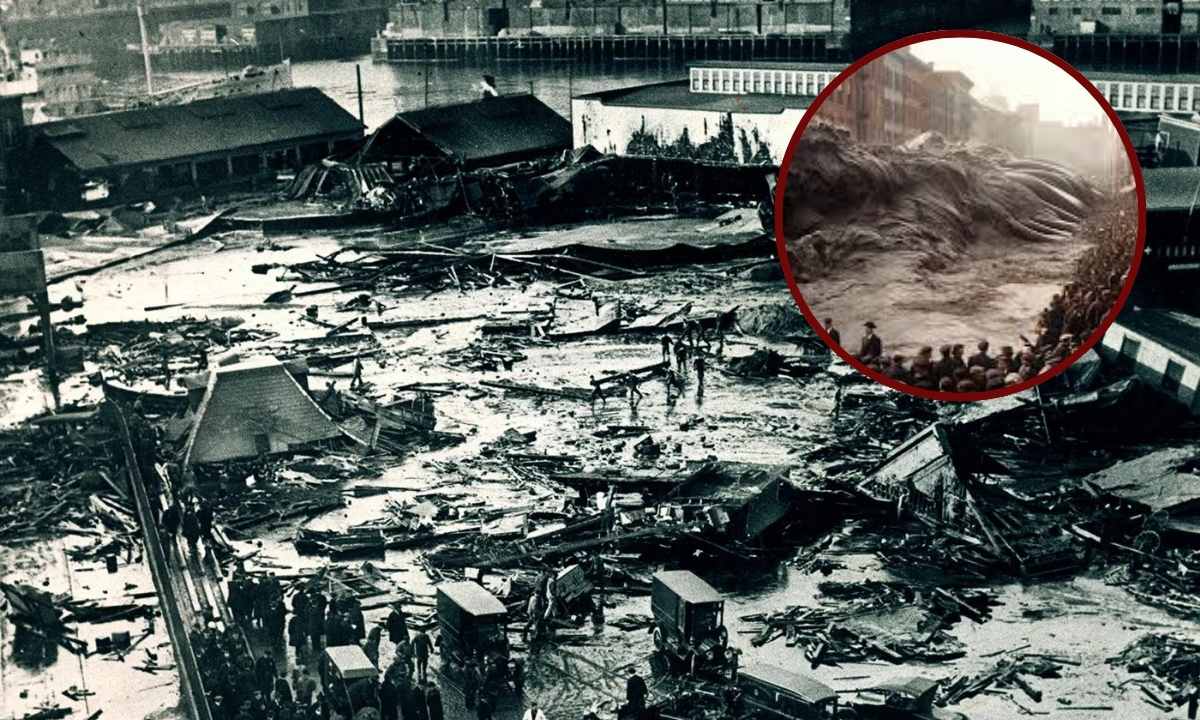A Deadly Wave Of Sugar Syrup Flooded The USA!
Imagine waking up to a sticky disaster that floods your city with over 2 million gallons of molasses. This might sound bizarre, but it actually happened on January 15, 1919, in the North End of Boston. ‘The Great Molasses Flood,’ a sticky disaster caused by the collapse of a storage tank at the Purity Distilling Company. The molasses waves which were 15 to 40 feet (5 to 12 metres) high and some 160 feet (49 metres) wide, crushed the city.
The massive destruction killed 21 people, many of whom were suffocated by the syrup. It also left approximately 150 injured. Boston Post mentioned the deaths as “died like so many flies on sticky fly paper.” Clean-up efforts took weeks, and the entire Boston continued to smell like molasses in the following years according to reports. But how did the tank break? and why was a such massive molasses tank there in the first place? Let’s find out.
The Sticky Disaster: The Day of The Flood
On that fateful day, Boston experienced a sudden rise in temperature, climbing above 40 degrees Fahrenheit after a period of freezing cold. Just the day before, a fresh shipment of molasses had been delivered and warmed to make it flow easier. This mixture of old cold molasses and the newly delivered warm molasses caused the tank to burst.
At about 12:30 PM, the massive tank, which was 50 feet tall and 90 feet in diameter, burst open. Witnesses described hearing a sound like a machine gun as the rivets popped, and the ground shook like an earthquake. A huge wave of molasses, up to 40 feet high and 160 feet wide, surged through the streets at 35 miles per hour.

The Molasses Waves!
Molasses is much denser than water, making the flood extremely powerful. This wave was strong enough to knock buildings off their foundations, crush vehicles, and even tip a streetcar off its tracks. People and animals were caught in the sticky mess.
“Molasses, waist deep, covered the street and swirled and bubbled about the wreckage […] Here and there struggled a form—whether it was animal or human being was impossible to tell. Only an upheaval, a thrashing about in the sticky mass, showed where any life was […] Horses died like so many flies on sticky fly-paper. The more they struggled, the deeper in the mess they were ensnared. Human beings—men and women—suffered likewise.”
Puleo quoted a Boston Post report
Anthony di Stasio, a child walking home with his sisters, was picked up by the wave and carried like he was surfing. He described his clogged throat with molasses and not being able to answer his mother’s calls.

Causes and Contributing Factors
Several issues led to the disaster. The tank had been leaking from the day it was built in 1915, and it was poorly constructed and not properly tested. The warmer weather increased the pressure inside the tank, which had a critical fatigue crack. Arthur Jell, the treasurer of the company, oversaw the tank’s construction without any engineering experience and ignored warning signs like groaning noises when the tank was filled.
Economic pressures also played a role. The company was rushing to produce as much molasses as possible before Prohibition, which was ratified the day after the disaster. This urgency led to cutting corners on safety.

Purpose of The Massive Tank of Molasses?
The tank was made along Boston’s waterfront on a commercial street in 1915. Purity Distilling Company, a subsidiary of United States Industrial Alcohol (USIA) operated the tank. In the early 1900s, making industrial alcohol from fermented molasses was highly profitable. It was also used in the making of munitions and other weaponry for World War I (1914–18).
The demand stood high and the size of the tank speaks for itself. The tank measured a height of 50 feet (15 meters) and a diameter of 90 feet (27 meters). It held up to 2.5 million gallons (9.5 million liters) of molasses. However, the tank had issues from the start. It often leaked and made noises. Ignoring the signs, they continued to use it. Following the conclusion of the war, the USIA focused on making grain alcohol.
Rescue Efforts in The Thickening Molasses
Rescue efforts began quickly, with 116 cadets from a nearby training ship rushing to help. They walked through knee-deep molasses to pull out survivors. The Boston Police, Red Cross, Army, and Navy also assisted. The thickening and hardening molasses made rescue difficult. It took four days to complete the search. Some bodies were found months later in Boston Harbor.

A Verdict for The Tank Owners
A class-action lawsuit was filed by 119 residents against the United States Industrial Alcohol Company, which owned Purity Distilling. The court found the company responsible, debunking their claim that anarchists had sabotaged the tank. The company paid $628,000 in damages, a significant amount for the time.

Cleanup Operations | Salt Water and Sand
Cleaning up the molasses was a huge task. Crews used salt water from fireboats and sand to absorb the sticky mess. The cleanup took weeks, and molasses spread throughout the city, making everything sticky for months. The harbor remained brown until the summer.
Harvard Study on the Disaster
In 2016, a team from Harvard University studied the disaster, using old maps, weather reports, and a scale model of the neighborhood. Their experiments with cold corn syrup validated historical accounts of the flood’s speed and impact, showing that the molasses cooled and thickened quickly, trapping many victims.
Conclusion
The Great Molasses Flood of 1919 was a unique and tragic disaster caused by a mix of human error, poor construction, and unfortunate weather conditions. It serves as a reminder of the importance of safety regulations and oversight to prevent similar incidents. This blend of history and human experience highlights how unexpected events can shape our understanding of industrial safety and urban life.
Also read,







